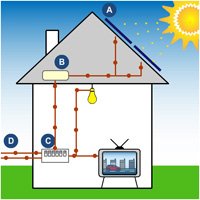RESIDENTIAL – SOLAR Panels Electricity
The sun emits a large amount of energy to the Earth and if it could all be harnessed, the amount of solar radiation that reaches the globe every 30 minutes would be enough to fulfil energy consumption requirements for a year worldwide. Solar Install supplies solar panels across the UK including solar panels Aberdeen, solar panels Newcastle and solar panels Wolverhampton – providing all the leading brands of solar PV panel technology:
1 – PHOTOVOLTAIC PANELS
 How do photovoltaic (PV) cells work? PV cells are panels you can attach to your roof or walls. Each cell is made from one or two layers of semiconducting material, usually silicon. When light shines on the cell it creates an electric field across the layers. The stronger the sunshine, the more electricity is produced.PV cells come in a variety of shapes and colours, from grey “solar tiles” that look like roof tiles to panels and transparent cells that you can use on conservatories and glass.
How do photovoltaic (PV) cells work? PV cells are panels you can attach to your roof or walls. Each cell is made from one or two layers of semiconducting material, usually silicon. When light shines on the cell it creates an electric field across the layers. The stronger the sunshine, the more electricity is produced.PV cells come in a variety of shapes and colours, from grey “solar tiles” that look like roof tiles to panels and transparent cells that you can use on conservatories and glass.
The strength of a PV cell is measured in kilowatt peak (kWp). That’s the amount of energy the cell generates in full sunlight. Solar electricity systems capture the sun’s energy using photovoltaic (PV) cells. The cells convert the sunlight into electricity, which can be used to run household appliances and lighting.
PV cells don’t need direct sunlight to work – you can still generate some electricity on a cloudy day.
The benefits of solar electricity
- Cut your carbon footprint: solar electricity is green, renewables energy and doesn’t release any harmful carbon dioxide (CO2) or other pollutants. A typical home PV system could save around 1tonne of CO2 per year – that’s around 25 tonnes over its lifetime.
- Cut your electricity bills: sunlight is free, so once you’ve paid for the initial installation your electricity costs will be greatly reduced. A typical home PV system can produce around 40% of the electricity a household uses in a year.
- Sell electricity back to the Grid: if your system is producing more electricity than you need, or when you can’t use it, someone else can use it – and you could make a bit of money.
Without releasing any greenhouse gases, the customer can start using their own generated electricity through using photovoltaic panels connected via a controller and inverter. The energy produced can be used to run the lighting and all general electrical appliances in the home, or work place.
To absorb as much of the sun’s energy as possible the panel will need to be mounted in a south facing direction, but the solar photovoltaic systems can be used in most buildings, for e.g. South West or South East.
- The government are offering a scheme where customers can claim a Feed in Tariff, or (FIT) this will benefit the customer further as this will reduce the payback period on any borrowing for the install cost.
- They save CO2 emissions by not producing greenhouse gases.
- Customers can choose from a full range of installation options including skylight, on-roof, canopy and façade.
INSTALLATION
 There are many factors that determine the performance of the photovoltaic panels. You need to take in to consideration the location, weather, aspect, shade and tilt when installing the panels.
There are many factors that determine the performance of the photovoltaic panels. You need to take in to consideration the location, weather, aspect, shade and tilt when installing the panels.
Planning permission may be required, depending on area especially conservation areas or listed buildings this should be checked before any installation goes ahead.
The solar photovoltaic system can connect into the local electricity network and any excess can be sold back to the grid. It is worth contacting your local electricity provider for further information.
For more information about solar panels, solar electricity and solar electric contact our trained team today.
